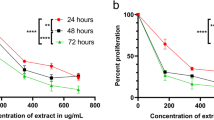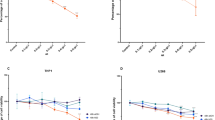Abstract
Plants have proved to be an important source of anti-cancer drugs. Wrightia arborea, an Indian Ayurvedic medicinal plant, is used traditionally to treat a variety of ailments. This study evaluates the antiproliferative/apoptotic potential of Wrightia arborea leaf extracts, prepared in different organic solvents, on cancer cell lines. MTT assay, light and fluorescence microscopy, flow cytometry, DNA laddering, alkaline comet assay, and western blotting were some of the techniques used for evaluation. Combinations of camptothecin, either with CHK1 inhibitor-PD407824 or with W. arborea leaf extract, were deployed to determine the G2 abrogating potential of the extract. The chloroform extract (WAC) selectively killed K562 cells, without affecting cancerous MCF-7, Hep G2 cells, and normal human peripheral blood lymphocytes. Cell death was characterized by observation of apoptotic bodies, increased Ca2+ and ROS, phosphatidyl serine externalization, mitochondrial membrane depolarization, DNA laddering, increased sub-G1 population, and altered expression of caspase 3, −9, and PARP. WAC also induced DNA damage, alterations in key G2/M phase protein expression, cell cycle perturbation, and potent G2 abrogation. The present study showed that W. arborea leaf extract, WAC, is capable of selectively killing leukemic cancer cells leaving normal lymphocytes unaffected. Our results indicate that this is effectuated through DNA damage and G2 abrogation leading to mitochondrial apoptosis. Taken together, this report contributes toward a better understanding of the anticancer properties of this traditional medicinal plant extract possessing valuable bioactive constituents which can serve as a bioresource for promising complimentary/alternative/chemopreventive therapeutics.















Similar content being viewed by others
References
Alves APR, Machado-Neto JA, Scheucher S, Paiva HH, Simoes BP, Rego EM, Traina F (2016) Reversine triggers mitotic catastrophe and apoptosis in K562 cells. Leuk Res 48:26–31
Anand A, Kunnumakara AB, Sundaram C, Harikumar KB, Tharakan AT, Lai OS, Sung B, Aggarwal BB (2008) Cancer is a preventable disease that requires major lifestyle changes. Pharm Res 25:2097–2116
Archana M, Bastian, Yogesh TL, Kumaraswamy KL (2013) Various methods available for detection of apoptotic cells—a review. Indian J Cancer 50:274–283
Astuti P, Utami ED, Nugrahani AW, Sudjadi S (2012) Genistein abrogates G2 arrest induced by curcumin in p53 deficient T47D cells. DARU J Pharm Sci 20:82. doi:10.1186/2008-2231-20-82
Ausubel FM, Brent R, Kingston RE, Moore DD, Seidman J, Smith JA, Struhl K (1992) Short protocols in molecular biology. John Wiley & Sons, USA, pp 10.8.1–10.8.23
Berglind H, Pawitan Y, Kato S, Ishioka C, Soussi T (2008) Analysis of p53 mutation status in human cancer cell lines: a paradigm for cell line cross-contamination. Cancer Biol Ther 7:699–708
Biswas J, Roy M, Mukherjee A (2015) Anticancer drug development based on phytochemicals. J Drug Discov Develop and Deliv 2:1012
Chopra RN, Nayar SI and Chopra IC (1956) Wrightia. In:Glossary of Indian medicinal plants. 3rd edn. Council of Scientific and Industrial Research, New Delhi, pp 259
Cragg GM, Newman DJ (2013) Natural product—a continuing source of novel drug leads. Biochipm Biophys Acta 1830:3670–3695
Daud AI, Ashworth MT, Strosberg J, Goldman JW, Mendelson D, Springett G, Venook AP, Loechner S, Rosen LS, Shanahan F, Parry D (2015) Phase I dose-escalation trial of checkpoint kinase 1 inhibitor MK-8776 as monotherapy and in combination with gemcitabine in patients with advanced solid tumors. J Clin Oncol 33:1060–1066
Devi SL, Divakar CM (2012) Wound healing activity studies of Wrightia arborea phytosome in rats. Hygeia J D Med 4:87–94
Feng Q, Cao H, Xu W, Li X, Ren Y, Du L (2011) Apoptosis induced by genipin in human leukemia K562 cells: involvement of c-Jun N-terminal kinase inG2/M arrest. Acta Pharmacol Sin 31:519–527
Ginsburg H, Deharo E (2011) A call for using natural compounds in the development of new antimalarial treatments—an introduction. Malar J 10:1. doi:10.1186/1475-2875-10-S1-S1
Gomes A, Fernandes E, Lima JLFC (2005) Fluorescence probes used for detection of reactive oxygen species. J Biochem Biophys Methods 65:45–80
Hassan M, Watari H, Almaaty AA, Ohba Y, Sakuragi N (2014) Apoptosis and molecular targeting therapy in cancer. Biomed Res Int. doi:10.1155/2014/150845
Jackman M, Lindon C, Nigg EA, Pines J (2003) Active cyclin B1-Cdk1 first appears on centrosomes in prophase. Nat Cell Biol 5:143–148
Jain SP, Srivastava S, Singh J, Singh SC (2011) Traditional phytotherapy of Balaghat district, Madhya Pradesh. India Indian J Tradit Know 10:334–338
Jones CB, Clements MK, Wasi DSS (2000) Enhancement of camptothecin-induced cytotoxicity with UCN-01 in breast cancer cells: abrogation of S/G2 arrest. Cancer Chemother Pharmacol 45:252–258
Juyal P, Ghildiyal JC (2013) Medicinal phytodiversity of Bhabar tract of Gharwal Himalaya. J. Med. Plants 1:43–57
Kasibhatla S, Amarante-Mendes GP, Finucane D, Brunner T, Bossy-Wetzel E, Green DR (2006) Acridine orange/ethidium bromide(AO/EB) staining to detect apoptosis. Cold Spring Harb Protoc. doi:10.1101/pdb.prot4493
Kawabe T (2008) Cancer drug discovery and development. In: Dai W (ed) Checkpoint responses in cancer therapy. Humana Press, Totowa, pp 117–133
Khalil HS, Tummala H, Chakarov S, Zhelev N, Lane DP (2012) Targeting ATM pathway for therapeutic intervention in cancer. Biodiscovery 1, DOI:10.7750/BioDiscovery.2012.1.3
Khayde MS, Vaikos NP (2011) Comparative phytochemical and antibacterial studies on the bark of Wrightia tinctoria and Wrightia arborea. Int J Pharma Bio Sci 2:176–181
Kim KY, Cho HJ, Yu SN, Kim SH, Yu HS, Park YM, Mirkheshti N, Kim SY, Song CS, Chatterjee B, Ahn SC (2012) Interplay of reactive oxygen species, intracellular Ca2+ and mitochondrial homeostasis in the apoptosis of prostate cancer cells by deoxypodophyllotoxin. J Cell Biochem 114:1124–1134
Kim T, Jung U, Cho DY, Chung AS (2001) Se-methylselenocysteine induces apoptosis through caspase activation in HL-60 cells. Carcinogenesis 22:559–565
Kimura M, Yoshioka T, Saio M, Banno Y, Nagaoka H, Okanoy Y (2003) Mitotic catastrophe and cell death induced by depletion of centrosomal proteins. Cell Death Dis 4:e603. doi:10.1038/cddis.2013.108
Liu MJ, Wang Z, Ju Y, Wong RNS, Wu QY (2005) Diosgenin induces cell cycle arrest and apoptosis in human leukemia K562 cells with the disruption of Ca2+ homeostasis. Cancer Chemother Pharmacol 55:79–90
Lopez J, Tait SWG (2015) Mitochondrial apoptosis: killing cancer using the enemy within. Br J Cancer 112:957–962
McCormack VA, Boffetta P (2010) Today’s lifestyles, tomorrow’s cancers: trends in lifestyle risk factors for cancer in low- and middle-income countries. Ann Oncol 11:2349–2357
Mosmann T (1983) Rapid colorimentric assay for cellular growth and survival: application to proliferation and cytotoxicity assays. J Imm Methods 65:55–63
Nahar L, Nasrin F, Zahan R, Mossadik MA (2013) Antinoiceptive and anti inflammatory activities of W. arborea. Pak J. Biol. Sci 16:485–490
Patwardhan B (2012) The quest for evidence-based Ayurveda: lessons learned. Curr sci 102:1406–1417
Rajan I, Jayasree PR, Kumar PRM (2015) Zerumbone induces mitochondria-mediated apoptosis via increased calcium, generation of reactive oxygen species and upregulation of soluble histone H2AX in K562 chronic myelogenous leukemia cells. Tumor Biol 36:8479–8489
Sahu RP, Batra S, Srivastava SK (2009) Activation of ATM/Chk1 by curcumin causes cell cycle arrest and apoptosis in human pancreatic cancer cells. Br J Cancer 100:1425–1433
Sharma A, Singh K, Almasan A (2012) Histone H2AX phosphorylation: a marker for DNA damage. Methods Mol Biol 920:613–626
Singh NP, McCoy MT, Tice RR, Schneider EL (1988) A simple technique for quantitation of low levels of DNA damage in individual cells. Exp Cell Res 175:184–191
Sivarajan VV, Balachandran I (1994) Kutajah (mal. Kutakappala) in: Ayurvedic drugs and their plant sources. Oxford and IBH publishing co pvt ltd, New Delhi, pp 268–269
Skwarska A, Augustin E, Konopa J (2007) Sequential induction of mitotic catastrophe followed by apoptosis in human leukemia MOLT4 cells by imidazoacridinone C-1311. Apoptosis 12:2245–2257
Sri BS, Reddi TS (2011) Traditional phyto-antidotes used for snakebite by Bagata tribe of Eastern Ghats of Visakhapatnam district, Andhra Pradesh. Int Multidiscip Res J 1:42–45
Steward WP, Brown K (2013) Cancer chemoprevention: a rapidly evolving field. Br J Cancer 109:1–7
Sturgeon CM, Cinel B, Díaz-Marrero AR, McHardy Ngo LM, Andersen RJ, Roberge M (2008) Abrogation of ionizing radiation-induced G2 checkpoint and inhibition of nuclear export by Cryptocarya pyrones. Cancer Chemother Pharmacol 61:407–413
Sui M, Zhang H, Di X, Chang J, Shen Y, Fan W (2012) G2 heckpoint abrogator abates the antagonistic interaction between antimicrotubule drugs and radiation therapy. Radiother Oncol 104:243–248
Vermes I, Haanen C, Steffens-Nakken H, Reutellingsperger C (1995) A novel assay for apoptosis flow cytometric detection of phosphatidylserine expression on early apoptotic cells using fluorescein labelled annexin V. J Immunol Methods 184:39–51
Wagner H (2011) Synergy research: approaching a new generation of phytopharmaceuticals. Fitoterapia 82:34–37
Zahan R, Nahar L, Mosaddik A, Rashid MA, Hassan A, Ahmed M (2013) Evaluation of antioxidant and antitumor activities of Wrightia arborea. J Basic Appl Sci 9:625–632
Zhen X, Cen J, Li YM, Yan F, Guan T, Tang XZ (2011) Cytotoxic effect and apoptotic mechanism of tanshinone A, a novel tanshinone derivative, on human erythroleukemic K562 cells. Eur J Pharmacol 667:129–135
Acknowledgements
Lakshmipriya T. acknowledges the financial support from University Grants Commission (Govt. of India) for Rajiv Gandhi National Fellowship. The authors thank Dr. Pradeep, Dept. of Botany, University of Calicut, for plant identification; Dr. Santhosh Kumar K., Rajiv Gandhi Centre for Biotechnology, Thiruvananthapuram, for allowing the use of FACS machine; and Mrs. Indu Ramachandran for technical help with FACS.
Author information
Authors and Affiliations
Corresponding author
Ethics declarations
Conflict of interest
The authors declare that they have no conflict of interest.
Additional information
Handling Editor: Jan Raoul De Mey
Electronic supplementary material
Supplementary Fig. 1
(DOC 772 kb).
Rights and permissions
About this article
Cite this article
Lakshmipriya, T., Soumya, T., Jayasree, P.R. et al. Selective induction of DNA damage, G2 abrogation, and mitochondrial apoptosis by leaf extract of traditional medicinal plant Wrightia arborea in K562 cells. Protoplasma 255, 203–216 (2018). https://doi.org/10.1007/s00709-017-1137-5
Received:
Accepted:
Published:
Issue Date:
DOI: https://doi.org/10.1007/s00709-017-1137-5




